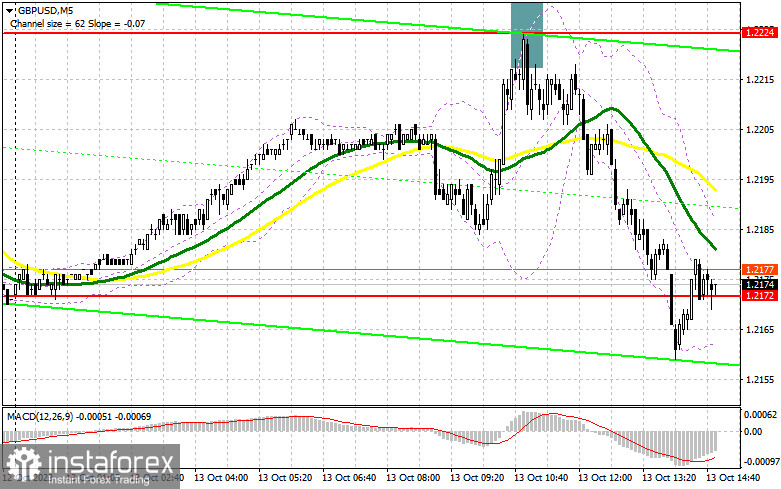In my morning forecast, I drew attention to the level of 1.2224 and recommended using it as a basis for market entry decisions. Let's take a look at the 5-minute chart and analyze what happened there. The rise and the formation of a false breakout at 1.2224 signaled a selling opportunity, which resulted in a significant drop towards the support level at 1.2172, allowing traders to pull about 50 points of profit from the market. In the second half of the day, the technical picture was slightly revised.

To open long positions on GBP/USD:
Ahead, we have data on the University of Michigan's consumer sentiment index and inflation expectations. If the indicators surpass economists' expectations, it's likely that the pressure on the pair will persist. It's best to act on buying during a decline after forming a false breakout around the nearest support at 1.2141. This, along with a divergence on the MACD indicator, will provide a buying signal with a slight pair recovery towards 1.2181. Breaking above and securing positions within this range will allow buyers to regain control, while a top-down retest will lead to a buying signal with an update to 1.2221. The ultimate target will be the area around 1.2267, where I will make profits. In the scenario of a drop to 1.2141 with no activity in the second half of the day, things will not look promising for pound buyers, which will open the path to 1.2108. Only a false breakout will provide a signal to open long positions. I plan to buy GBP/USD immediately on a rebound only from a minimum of 1.2071, with a target of a 30-35 point intraday correction.
To open short positions on GBP/USD:
The bears need to defend the nearest resistance at 1.2181, but doing so will be quite challenging. Therefore, a false breakout at this level, similar to what I discussed earlier, and data indicating an increase in US consumer sentiment will provide a selling signal that could push the pair down to 1.2141. Breaking through and retesting the bottom-up of this range will deal a more significant blow to buyer positions, opening the way to a minimum of 1.2108. The more distant target will be 1.2071, where I will take profits. In the case of GBP/USD rising and no activity at 1.2181 in the second half of the day, trading will move within the confines of a sideways channel, and there will be nothing interesting to expect from today. In this scenario, I will postpone selling until a false breakout at 1.2221. If there's no downward movement, I will sell the pound immediately on a rebound from 1.2267, but only with the expectation of a downward pair correction of 30-35 points.


Indicator Signals:
Moving averages
Trading is occuring below the 30 and 50-day moving averages, indicating further decline in the pair.
Note: The author considers the period and prices of the moving averages on the H1 hourly chart, which differs from the general definition of classic daily moving averages on the D1 daily chart.
Bollinger Bands
In case of a decline, the lower boundary of the indicator around 1.2160 will act as support.
Description of indicators:
Moving average (determines the current trend by smoothing volatility and noise). Period 50. Marked in yellow on the chart.Moving average (determines the current trend by smoothing volatility and noise). Period 30. Marked in green on the chart.MACD indicator (Moving Average Convergence/Divergence - convergence/divergence of moving averages) Fast EMA period 12. Slow EMA period 26. SMA period 9.Bollinger Bands. Period 20.Non-commercial traders - speculators such as individual traders, hedge funds, and large institutions that use the futures market for speculative purposes and meet certain requirements.Long non-commercial positions represent the total open long positions of non-commercial traders.Short non-commercial positions represent the total open short positions of non-commercial traders.The net non-commercial position is the difference between the short and long positions of non-commercial traders.




















